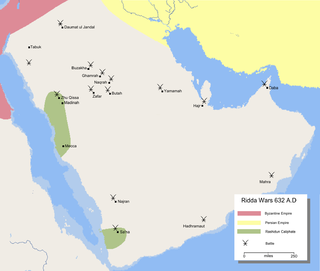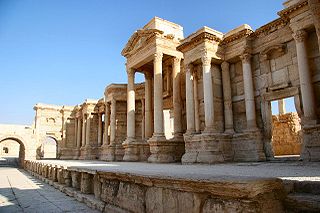History
Umar appointed Hudheifa to the command of the campaign. Hudheifa first marched to Zanjan. The local garrison defended itself but was eventually overpowered and the city fell.
The Muslim forces proceeded to Ardabil where the Persians did not resist and surrendered on the usual terms of Jizya (the annual tax levied on non-Muslims). From Ardabeel, the Muslim forces marched northward along the western coast of the Caspian Sea. A confrontation ensued at the Bab area which was an important port on the Caspian Sea. The Muslims scored another victory, but for unknown reasons, Hudheifa was recalled.
The Persians then launched a counterattack, causing the Muslims to abandon their forward posts in Azarbaijan. As a response, Umar sent expeditionary forces to Azarbaijan, one led by Bukair ibn Abdullah and another by Utba bin Farqad. The contingent under Bukair confronted the Persians at Jurmizan. The Persians were commanded by Isandiar. The battle was quite severe, the Persians were defeated and their commander Isandiar was captured alive. Isandiar asked Bukair, "Do you prefer war or peace?" to which Bukair replied that the Muslims preferred peace. Isandiar thereupon said, "Then keep me with you till I can help you in negotiating peace with the people of Azarbaijan". The Persians went to nearby hill forts and shut themselves within. The Muslims captured the entire area in the plains. [2]
During the year of 25 Hijr, the Mushaf Uthmani of Quran was created in an attempt to avoid linguistic confusion of Qur'an which had been translated to local dialect of Azerbaijan and Armenia. Hudhaifa warned Uthman that the translation would lose its original Tafseer if it failed to standardise in the original Mushaf version first, before the locals could translate and give commentary. [3]

Uthman ibn Affan ibn Abi al-As was the third Rashidun caliph, ruling from 644 until his assassination in 656. Uthman, a second cousin, son-in-law, and notable companion of the Islamic prophet Muhammad, played a major role in early Islamic history. During his reign as caliph, he was known for ordering the official compilation of the standardized version of the Quran that is still being used today.

Umar ibn al-Khattab was the second Rashidun caliph, ruling from August 634 until his assassination in 644. He succeeded Abu Bakr as the second caliph of the Rashidun Caliphate on 23 August 634. Umar was a senior companion and father-in-law of the Islamic prophet Muhammad. He was also an expert Muslim jurist known for his pious and just nature, which earned him the epithet al-Fārūq. The title Amir al-Mu'minin was held by Umar ibn Khattab who was also the first one to be given this title.

The Muslim conquest of Persia, also called the Muslim conquest of Iran, the Arab conquest of Persia, or the Arab conquest of Iran, was a major military campaign undertaken by the Rashidun Caliphate between 632 and 654. As part of the early Muslim conquests, which had begun under Muhammad in 622, it led to the fall of the Sasanian Empire and the eventual decline of Zoroastrianism, which had been predominant throughout Persia as the nation's official religion. The persecution of Zoroastrians by the early Muslims during and after this conflict prompted many of them to flee eastward to India, where they were granted refuge by various kings.

The Ridda Wars were a series of military campaigns launched by the first caliph Abu Bakr against rebellious Arabian tribes. They began shortly after the death of the Islamic prophet Muhammad in 632 and concluded the next year, with all battles won by the Rashidun Caliphate. These wars secured the caliphate's control over Arabia and restored its nascent prestige.
Al-Miqdad ibn Amr al-Bahrani, better known as al-Miqdad ibn al-Aswad al-Kindi or simply Miqdad, was one of the companions of the Islamic prophet Muhammad. His kunya was Abu Ma'bad. Miqdad was born in Eastern Arabia. He became fugitive in his hometown and ran to Mecca, where he served Aswad al-Kindi. Miqdad managed to gain favor of his master, who in turn adopted him as his son.

The Battle of Ayn al-Tamr took place in modern-day Iraq (Mesopotamia) between the early Muslim Arab forces and the Sassanians along with their Arab Christian auxiliary forces. Ayn al-Tamr is located west of Anbar and was a frontier post which had been established to aid the Sassanids.

The Muslim conquest of the Levant, or Arab conquest of Syria, was a 634–638 CE invasion of Byzantine Syria by the Rashidun Caliphate. A part of the wider Arab-Byzantine Wars, the Levant was brought under Arab Muslim rule and developed into the provincial region of Bilad al-Sham. Clashes between the Arabs and Byzantines on the southern Levantine borders of the Byzantine Empire had occurred during the lifetime of Muhammad, with the Battle of Muʿtah in 629 CE. However, the actual conquest did not begin until 634, two years after Muhammad's death. It was led by the first two Rashidun caliphs who succeeded Muhammad: Abu Bakr and Umar ibn al-Khattab. During this time, Khalid ibn al-Walid was the most important leader of the Rashidun army.

The Battle of Ullais was fought between the forces of the Rashidun Caliphate and the Sasanian Persian Empire in the middle of May 633 AD in Iraq, and is sometimes referred to as the Battle of Blood River since, as a result of the battle, there were enormous amounts of Persian Sasanian and Arab Christian casualties.

Umar was the second Rashidun Caliph and reigned during 634–644. Umar's caliphate is notable for its vast conquests. Aided by brilliant field commanders, he was able to incorporate present-day Iraq, Iran, Azerbaijan, Armenia, Georgia, Syria, Jordan, Palestine, Lebanon, Egypt, and parts of Afghanistan, Turkmenistan and south western Pakistan into the Caliphate. During his reign, the Byzantines lost more than three fourths of their territory and in Persia, and Umar was the king (ruler) of the Sassanid Empire before it ceased to exist.

The Rashidun Caliphate was the first caliphate to succeed the Islamic prophet Muhammad. It was ruled by the first four successive caliphs of Muhammad after his death in 632 CE. During its existence, the empire was the most powerful economic, cultural, and military force in West Asia and Northeast Africa.
Abū ʿAbd al-Raḥmān ʿAbd Allāh ibn ʿĀmir ibn Kurayz was a Rashidun politician and general, serving as governor of Basra from 647 to 656 AD during the reign of Rashidun Caliph Uthman ibn Affan. He was a cousin of the Caliph through his father. He is known for his administrative and military prowess including his successful campaigns of reconquest and pacification of former territories of the Sasanian Empire in what is now Iran and Afghanistan.
The Rashidun army was the core of the Rashidun Caliphate's armed forces during the early Muslim conquests in the 7th century. The army is reported to have maintained a high level of discipline, strategic prowess and organization, granting them successive victories in their various campaigns.

The Battle of Rasil was fought between the Rashidun Caliphate and the Rai kingdom ruled by Raja Rasil in early 644. It was the first encounter of the Rashidun Caliphate in the Indian subcontinent. The exact location of the battle is not known, but historians suggest it was fought on the western bank of the River Indus.
The Battle of Jalula was fought between the Sasanian Empire and the Rashidun Caliphate soon after conquest of Ctesiphon. After the capture of Ctesiphon, several detachments were immediately sent to the west to capture Qarqeesia and Heet the forts at the border of the Byzantine empire. Several strong Persian armies were still active north-east of Ctesiphon at Jalula and north of the Tigris at Tikrit and Mosul. The greatest threat of all was the Persian concentration at Jalula. After withdrawal from Ctesiphon, the Persian armies gathered at Jalula north-east of Ctesiphon, a place of strategic importance from where routes led to Iraq, Khurasan and Azerbaijan. The Persian forces at Jalula were commanded by General Mihran. His deputy was General Farrukhzad a brother of General Rostam Farrokhzād, who had commanded the Persian forces at the Battle of Qadisiyyah. As instructed by the Caliph Umar, Saad ibn Abi Waqqas reported all the matter to Umar. The Caliph decided to deal with Jalula first; his plan was first to clear the way north before any decisive action against Tikrit and Mosul. Umar appointed Hashim ibn Utba to the expedition to Jalula. Some time in April 637, Hashim marched at the head of 12,000 troops from Ctesiphon and after defeating the Persians at the Battle of Jalula, laid siege to Jalula for seven months, until it surrendered on the usual terms of Jizya.
Al-Qaʿqāʿ ibn ʿAmr ibn Mālik Al-Tamīmī was an Arab Muslim commander and general in the Rashidun army who belonged to the tribe of Banu Tamim. He and his tribe converted to Islam possibly during the time of Ahnaf ibn Qais. He is known as a successful military commander who took part in two important victorious battles in the early Muslim Conquest, the Battle of Yarmouk against the Byzantine Empire and the Battle of al-Qadisiyyah against the Sassanian Empire which was led by Sa`d ibn Abi Waqqas. The Caliph Abu Bakr praised him as an equal to eleven thousand men so in return the caliph's successor, caliph Umar, only sent Qaʿqāʿ and a handful of bodyguards in the first wave of reinforcements to Al-Qadissiyah. Qaʿqāʿ was one of the most illustrious military figures of his era.

The Arab conquest of Mesopotamia was carried out by the Rashidun Caliphate from 633 to 638 AD. The Arab Muslim forces of Caliph Umar first attacked Sasanian territory in 633, when Khalid ibn al-Walid invaded Mesopotamia, which was the political and economic centre of the Sasanian state. From 634 to 636 AD, following the transfer of Khalid to the Byzantine front in the Levant, the hold of Arab forces on the region weakened under the pressure of Sasanian counterattacks. A second major Arab offensive in 636 and ended in January 638 with the capture of Mosul and the consolidation of Arab control over and exclusion of Sasanid influence from the whole Mosul-Tikrit region.
Iyad ibn Ghanm ibn Zuhayr al-Fihri was an Arab commander who played a leading role in the Muslim conquests of al-Jazira and northern Syria. He was among the handful of Qurayshi tribesmen to embrace Islam before the mass conversion of the tribe in 630, and was a companion of the Islamic prophet Muhammad. In 634, under Caliph Abu Bakr, he governed the north Arabian oasis town of Dumat al-Jandal. Later, in 637, he became governor of al-Jazira, but was dismissed by Caliph Umar for alleged improprieties. Afterward, he became a close military aide of his cousin and nephew, Abu Ubayda ibn al-Jarrah, under whose direction Iyad conquered much of Byzantine-held northern Syria, including Aleppo, Manbij and Cyrrhus.
Dhiraar ibn al-Khattab was a warrior participating in the early Islamic conquests. Dhiraar's father, al-Khattab bin Mirdas bin Kathir, was the head of the Banu Fihr clan of Quraish subclan are found throughout his works. Khattab bin Mirdas has lineage through their grandfather, Fihr ibn Malik, with the Prophet. His mother was Hind bint Malik Umm Dhiraar bint Amr, and His uncle was Hafs bin Mirdas.

The Arab Empire maintained and expanded a wide trade network across parts of Asia, Africa and Europe. This helped establish the Arab Empire as the world's leading economic power throughout the 8th–13th centuries according to the political scientist John M. Hobson. It is commonly believed that Mu‘awiya Ibn Abi Sufyan was the first planner and establisher of the Islamic navy.










